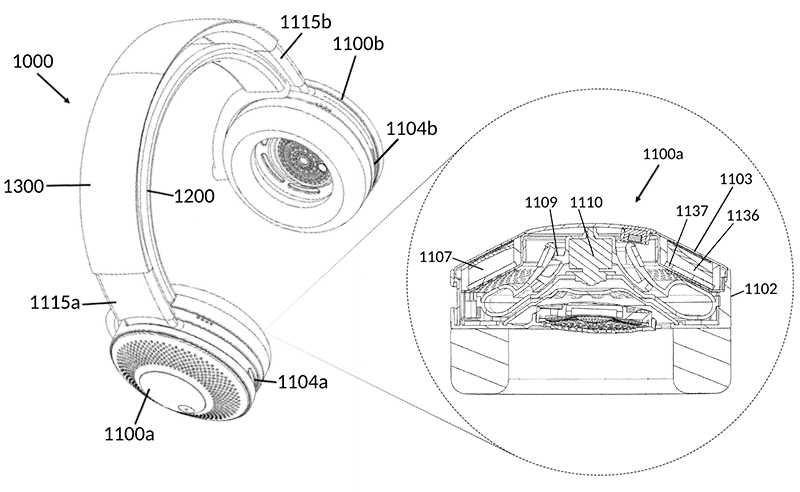Face masks, including air-purifying respirators and dust masks, are worn by users to minimise their exposure to air pollution. This can make breathing laborious and speaking with others difficult.
Alternative devices include wearable air purifiers, such as those worn around the neck of a user to create a jet of air that is directed towards the mouth and nose. However, as the mouth and nose are uncovered, exposure to air pollution may not be adequately minimised. Also, the jet of air may not always be accurately delivered to the user.
In December 2020, Dyson Technology Ltd was granted UK patent, GB2575812, titled A wearable air purifier, which claims a head-wearable air purifier (‘purifier’, 1000 in image above) comprising speaker assemblies (1100a, 1100b) to be worn over a user’s ears – the speaker assemblies may be connected by an arcuate headband (1200).
The speaker assembly (1100a) includes a filter assembly (1107), an impeller (1109) for creating an airflow through the filter assembly, a motor (1110) arranged to drive the impeller, and an air outlet (1104a) downstream from the filter assembly for emitting the filtered airflow from the speaker assembly. The speaker assembly may also include a housing (1102) with an air inlet (1103). The purifier includes a nozzle (1300) arranged to receive the filtered airflow from the speaker assembly.
In the illustrated embodiment, a rigid outlet duct (1115) is configured to revolve between a first position, whereby it is aligned with the air outlet so that airflow emitted from the air outlet passes into it, and a second position (shown) which enables the nozzle to be stowed over the headband when not in use.
In the first position, the nozzle is designed to extend around the user’s face, from one ear to the other, and over at least the mouth. The purifier is provided with a sensor that detects when the rigid outlet duct is not aligned with the air outlet and automatically turns off the motor. Further, the nozzle may be rotated independently without affecting any of the components that are internal to the speaker housing.
The nozzle comprises an air outlet arranged to emit the received filtered airflow from the purifier. This may include, for example, an array of apertures in a section of the nozzle that faces towards the mouth and nose of the user. Optionally, the filtered airflows generated by the speaker assemblies will travel in opposite directions within an interior passage of the nozzle, colliding in the vicinity of the centre of the nozzle. The combined filtered airflow is then directed through the apertures in the nozzle, towards the mouth and nose of the user.
The filter assembly is provided upstream of the impeller and comprises one or more generally frusto-conical filter elements (1136, 1137). The filter elements may be supported by a filter seat having a plurality of apertures. Air must therefore pass through the filter elements before passing through the apertures in the filter seat and into impeller casing.
Optionally, the filter assembly may include both a particulate filter element and a chemical filter element, with the particulate filter element located upstream relative to the chemical filter element.
In December 2020, Dyson Technology Ltd was granted a further three UK patents, GB2575813, GB2575814 and GB2575815, which are all also titled A wearable air purifier. These patents, respectively, disclose further improvements in relation to the impeller casing, the impeller and the control circuit for controlling the rotational speed of the impeller.
Read the full patent here
This article first appeared in the February 2021 issue of Materials World, the member magazine of the Institute of Materials, Minerals and Mining.


